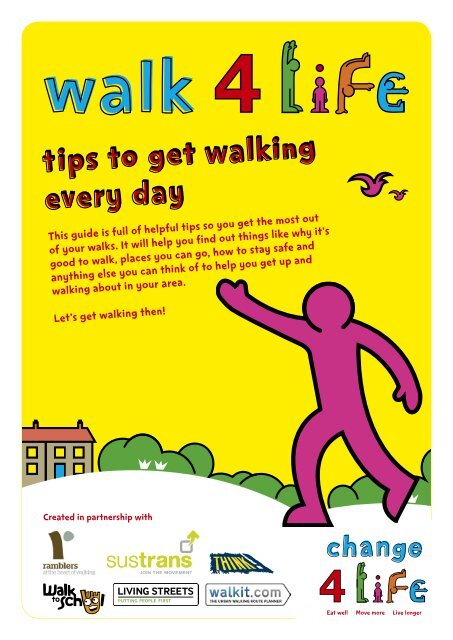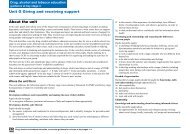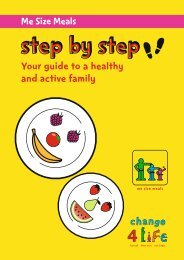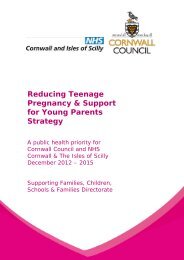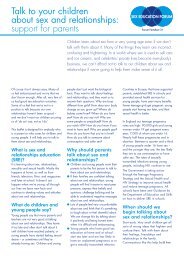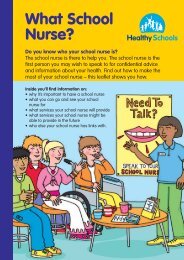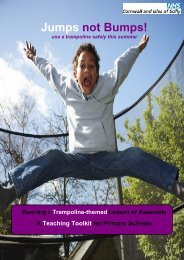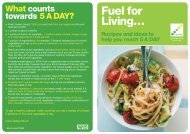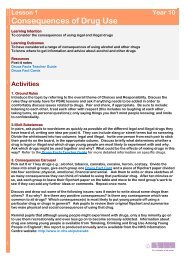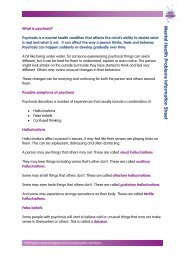Walk 4 life: Tips to get walking every day
Walk 4 life: Tips to get walking every day
Walk 4 life: Tips to get walking every day
- No tags were found...
You also want an ePaper? Increase the reach of your titles
YUMPU automatically turns print PDFs into web optimized ePapers that Google loves.
walk<strong>Tips</strong> <strong>to</strong> <strong>get</strong> <strong>walking</strong><strong>every</strong> <strong>day</strong>This guide is full of helpful tips so you <strong>get</strong> the most ou<strong>to</strong>f your walks. It will help you find out things like why it’sgood <strong>to</strong> walk, places you can go, how <strong>to</strong> stay safe andanything else you can think of <strong>to</strong> help you <strong>get</strong> up and<strong>walking</strong> about in your area.Let’s <strong>get</strong> <strong>walking</strong> then!Created in partnership with
why Why walk?The first question you might have is “Why should I go for a walk?” The answeris that <strong>walking</strong> is a great way for families <strong>to</strong> be up and about, whether it’s <strong>walking</strong><strong>to</strong> the shops, <strong>to</strong> school, up stairs, <strong>walking</strong> the dog or just going for a leisurely strollwith family and friends. It doesn’t need any special equipment and doesn’t costanything either!And since <strong>walking</strong> doesn’t cause congestion or pollution, whenever you choose<strong>to</strong> walk rather than take the car, you’re being kind <strong>to</strong> our environment as wellas <strong>to</strong> your health.Top 5 <strong>walking</strong> factsHere are 5 things you might not know about <strong>walking</strong>:• It’s easy <strong>to</strong> think you’re protecting the kidsfrom fumes by keeping them inside the car.But pollution inside can be up <strong>to</strong> three timesthe level it is outside on the pavement – so stepout and enjoy the fresh air!• If we all swapped one car journey a week for<strong>walking</strong>, car traffic would reduce by at least 10%.More than just <strong>walking</strong>Another great thing about <strong>walking</strong> is that it letsyou do two or more things at once. So whileyou’re out and about you could also be:• Getting <strong>to</strong> places you need <strong>to</strong> visit, like work,school or the shops.• Spending time with friends, children and family.<strong>Walk</strong>ing and talking go hand-in-hand and youmight even make new friends along the way!• The average person could save £160 <strong>every</strong> yearby <strong>walking</strong> instead of driving the journey <strong>to</strong> school– just think what fun you could have with thatextra money...• <strong>Walk</strong>ing just 1 mile burns over 100 calories!• About a third of all the journeys we make are lessthan a mile. A mile is only about a 20 minute walk.It can do you the world of good <strong>to</strong>o• Exploring your local area – it’s the best way<strong>to</strong> discover hidden places you might not knoware there.• Enjoying green spaces and nature – fresh air,peace and quiet, and a place for the kids <strong>to</strong>run around.• Or just taking time <strong>to</strong> relax by yourself!Because <strong>walking</strong> helps <strong>to</strong>wards your ‘60 active minutes’ a <strong>day</strong>, it can reduce your chances of <strong>get</strong>ting seriousillnesses like cancer, type 2 diabetes and heart disease in the future.We all know how a good walk can help us collect our thoughts, and being out in the fresh air is a great way<strong>to</strong> de-stress and improve our mood.
<strong>Walk</strong>ing’s just not for me...Here are some common reasons why people feel they can’t go for walks. Are any ofthem the same as your reasons? Hopefully you’ll see that anyone can start <strong>walking</strong>,whatever they do and wherever they live.“I don’t have the time”<strong>Walk</strong>ing is the easiest exercise <strong>to</strong> fit in<strong>to</strong> a busy<strong>life</strong>style since you can do it anywhere at a timethat suits you. It’s better than sweating on a packedbus or train, or <strong>get</strong>ting stressed in a traffic jam.You’ll still have <strong>to</strong> make a little effort <strong>to</strong> find time,but remember active people live longer and have ahealthier old age. So think of your <strong>walking</strong> time as agood investment!“I don’t know any good places<strong>to</strong> walk”Sometimes main roads don’t feel like the nicest andsafest places <strong>to</strong> walk. But there are lots of quieterstreets, parks, watersides and green spaces even inbusy urban areas if you know where <strong>to</strong> look forthem. Ask friends if they know good areas <strong>to</strong> walk,visit your local council’s website or go <strong>to</strong> yourlibrary and look at maps of your area. You can alsofind lots of organised walks by visiting the ‘<strong>Walk</strong>ingthe Way <strong>to</strong> Health’ website here <strong>to</strong> help you findplaces that are fun <strong>to</strong> <strong>get</strong> <strong>to</strong> on foot.“I don’t feel safe on the streets”It’s understandable that people are concerned fortheir personal safety, but it doesn’t have <strong>to</strong> s<strong>to</strong>pyou enjoying the benefits of <strong>walking</strong>. If you can,walk with a companion or on an organised walk,and see the section on safety in this guide formore tips on <strong>walking</strong> safely. Also, the morepeople who walk, the safer the streets will be!“I don’t have anyone <strong>to</strong> walk with”Ask your family, friends and colleagues if they’reinterested in <strong>walking</strong> with you. Or try an organisedwalk – you can find out about these by searchingfor them online (www.walkengland.org.uk is a goodplace <strong>to</strong> start).“My kids won’t walk”Exercise is really important for kids, but it can bedifficult <strong>to</strong> <strong>get</strong> them away from indoor activitieslike watching TV. Take a look at the ‘Fun games for<strong>every</strong> <strong>day</strong> <strong>walking</strong>’ and ‘Fun <strong>walking</strong> games forparks and woodland’ here for great ideas <strong>to</strong> make<strong>walking</strong> more interesting for them.“I’m <strong>to</strong>o unfit <strong>to</strong> walk”<strong>Walk</strong>ing is a natural and easy exercise that you canstart doing in small amounts and build up slowly.That makes it perfect for people who are very unfi<strong>to</strong>r recovering from an illness. Very few of us are sounfit that we’d endanger ourselves by <strong>walking</strong>, butif you have any doubts, talk <strong>to</strong> your doc<strong>to</strong>r first.There are so many good reasons<strong>to</strong> start <strong>walking</strong>, the only thingyou have <strong>to</strong> do now is choosewhere <strong>to</strong> go first!
<strong>walking</strong> is easierthan you thinkYou can walk pretty much anywhere. To the shops, <strong>to</strong> school, <strong>to</strong> see friends, <strong>to</strong> thepark – all you need <strong>to</strong> do is step out of your front door and decide where you’d like <strong>to</strong>go. Try <strong>get</strong>ting off the bus 1 or 2 s<strong>to</strong>ps early and walk the rest of the way, or walk <strong>to</strong>the next s<strong>to</strong>p instead of waiting for the bus – it’s that easy!Here are some things <strong>to</strong> think about so you make themost of your walk:• Make sure you’re wearing comfortable clothesand shoes.• A few thin layers of clothing are better thanone thick layer. So you can take off layers asyou warm up, or add them if you <strong>get</strong> cold!• Unless you’re sure it’s not going <strong>to</strong> rain, takea jacket – it’s easier than holding an umbrella.<strong>Walk</strong> this wayHere are our <strong>to</strong>p tips <strong>to</strong> make sure your walksare as comfortable and easy as possible:• Stand up straight but relaxed and look ahead.• Try <strong>to</strong> swing your arms in time with your stride.• Breathe deeply and in rhythm with your stepsif you can.• A hat can keep you warm in winter and protectyou from the sun in summer.• Wear gloves if it’s cold – it’s difficult <strong>to</strong> walkbriskly with your hands in your pockets.• Take some water and some food <strong>to</strong>o if you’regoing on a longer walk.• A small backpack is more comfortable <strong>to</strong> walkwith, and is better for your back than anordinary bag.
staying safeSome people are put off <strong>walking</strong> because they’re worried about being safe.But by taking a few precautions we can all feel safe while we walk.• Choose routes that are well-used, and well-litif you walk at night.• Know where you’re going – if you don’t know thearea well, take a map or leaflet.• Be prepared <strong>to</strong> change your route if you feelunsafe for any reason.• Take a travel pass or some change in case you need<strong>to</strong> use public transport.• Take a mobile phone and/or tell someone whereyou’ve gone if you’re going on a long walk.• If you’re wearing headphones, make sure you canhear traffic and are aware of <strong>every</strong>thing that’sgoing on around you.• Take care on busy roads and road crossings, andpaths used by cyclists.
safety Safety for kidsKids aren’t as good as we are at being aware of their surroundingsand judging things like the speed of traffic and how far away cars are.So it’s important that we help them understand road safety and givethem the confidence <strong>to</strong> walk on their own when they <strong>get</strong> older.Here’s the 5-step Green Cross Code that tells kids how <strong>to</strong> stay safewhen they’re out <strong>walking</strong>.1. First find a safe place <strong>to</strong> crossMake sure there is space <strong>to</strong> reach the pavement onthe other side. Where there is a crossing nearby, useit. It’s safer <strong>to</strong> cross using a subway, a footbridge, anisland, a zebra crossing or where there is a crossingpoint controlled by an adult.Otherwise choose a place where you can see clearlyin <strong>every</strong> direction. Try <strong>to</strong> avoid crossing betweenparked cars and on a blind bend or close <strong>to</strong> thebrow of a hill. Move <strong>to</strong> a space where drivers andriders can see you clearly.2. S<strong>to</strong>p just before you <strong>get</strong><strong>to</strong> the kerbCheck you can see if anything is coming and thatdrivers can see you. Do not <strong>get</strong> <strong>to</strong>o close <strong>to</strong> thetraffic. If there is no pavement, keep back from theedge of the road but make sure you can still seetraffic coming.. Look all around for trafficand listenTraffic could come from any direction. Listenas well, because you can sometimes hear trafficbefore you see it.. If traffic is coming, let it passLook all around again and listen. Do not cross untilthere is a safe gap in the traffic and you are surethat there’s plenty of time. Remember, even iftraffic is a long way off, it may be coming <strong>to</strong>wardsyou very quickly.5. When it is safe, go straightacross the road – do not runKeep looking and listening for traffic while youcross, in case there is any traffic you did not see, orin case other traffic appears suddenly. Look out forcyclists and mo<strong>to</strong>rbikes moving between lanes oftraffic. Don’t walk diagonally across the road.If you’re with very young kids, hold their hand whileyou cross the road. And if there is no pavement,walk on the right hand side of the road <strong>to</strong> face thetraffic coming <strong>to</strong>wards you. <strong>Walk</strong> one behind theother at bends in the road or at night or if there is alot of traffic.<strong>Walk</strong>ing at night‘Be bright, be seen’ is an easy way <strong>to</strong>help road users see you when it’s dark.Wear or carry something light colouredor bright – fluorescent and reflectivematerials are good for this as they showup in <strong>day</strong>light and at dusk.If you’d like <strong>to</strong> find out more aboutroad and pedestrian safety, visitthe Think! website here.
<strong>Walk</strong>ing <strong>to</strong> schoolThere are so many fantastic reasons why kids should walk <strong>to</strong> school.But you might not know that there are benefits for you <strong>to</strong>o...Why it’s good for kids• <strong>Walk</strong>ing <strong>to</strong> school is a great way <strong>to</strong> help kids<strong>to</strong>wards their ‘60 active minutes’ each <strong>day</strong>. Also,there could be quieter streets they can use whichhave fewer cars and less pollution. They mighteven be able <strong>to</strong> find a route through a park orother green space, which can help them feelcalmer and happier <strong>to</strong>o.• Getting <strong>to</strong> school by foot helps withconcentration. <strong>Walk</strong>ing burns off some of theirexcess energy and means they are better atsettling down and focusing in lessons.• <strong>Walk</strong>ing helps with road safety skills <strong>to</strong>o. If theylearn them when they’re young, they’re more likely<strong>to</strong> be safer walkers when they’re older.• If your child joins a <strong>walking</strong> bus, or is old enough<strong>to</strong> walk <strong>to</strong> school with friends, they’ll have moretime in the <strong>day</strong> <strong>to</strong> make friends and feelcomfortable around other people. And mostteenagers, like all of us, need time <strong>to</strong> themselves –<strong>walking</strong> home can be a good time <strong>to</strong> relax andthink about their <strong>day</strong>.Why it’s good for you• If you prefer <strong>to</strong> walk with your child <strong>to</strong> school,you’ll be keeping active with them! And becauseit’s much easier <strong>to</strong> know how long a journey onfoot will take you, you’ll probably be much lessstressed than if you were sitting in a traffic jam.• <strong>Walk</strong>ing <strong>to</strong> school might even save you time.If your school has a <strong>walking</strong> bus (read more aboutthese below), you could walk along only some <strong>day</strong>sof the week and leave the kids with other trustedparents on the other <strong>day</strong>s. And if your child isolder, they could walk home by themselves or withfriends – just think of all the time you’ll save notwaiting for them outside the school gates!• <strong>Walk</strong>ing more will save you money on petrol andpublic transport. Simple!<strong>Walk</strong>ing buses‘<strong>Walk</strong>ing buses’ are a great way of helping kids stayactive and <strong>get</strong> <strong>to</strong> school safely. Kids <strong>get</strong> picked upalong the way at set times and places along theroute, and walk in a large group supervised byteachers or parents.Find out if there’s a <strong>walking</strong> bus for your schoolthat goes through your area. You’ll help reducecongestion, make it cleaner and safer for <strong>every</strong>one,and avoid those traffic jams <strong>to</strong>o!Every year, around 2 million pupils join in with LivingStreets’ National <strong>Walk</strong> <strong>to</strong> School campaign – you can<strong>to</strong>o! For lots of <strong>to</strong>p tips on <strong>walking</strong> <strong>to</strong> school, visit the<strong>Walk</strong> <strong>to</strong> School website here.
When can kids walkon their own?Parents often ask: “When is it OK for my kids <strong>to</strong> walk <strong>to</strong> school on their own?”And the simple answer is when they – and you – feel ready. As there’s no legalminimum age when a child is allowed <strong>to</strong> walk on their own, it just depends on howconfident they are, where you live and how far away the school is.You and your kids should talk about it and decide between you. By following our tipsbelow, you’ll be able <strong>to</strong> choose the right time for them <strong>to</strong> <strong>get</strong> <strong>to</strong> school on their own.• Let your kids decide when it’s safe <strong>to</strong> cross theroad when you’re out <strong>to</strong><strong>get</strong>her. Ask them whatthey know about crossing the road and ‘strangerdanger’ so that they keep learning what they’rebeing taught about safety in school.• Practice <strong>walking</strong> <strong>to</strong> school <strong>to</strong><strong>get</strong>her and let themlead the way. Over time you could let them walkfurther ahead and start becoming moreindependent.• Tell the kids that they can change their mindabout <strong>walking</strong> <strong>to</strong> school on their own wheneverthey like. If they find they don’t like doing it,something changes on their journey (likeroadworks making crossing more dangerous) or ifthey decide they want company while they walk,that’s fine.• Let them know how you want them <strong>to</strong> behave onthe way <strong>to</strong> and from school and praise them whenthey do well.• They could start by just <strong>walking</strong> from school <strong>to</strong>home on their own so you’re there <strong>to</strong> meet them.That way you know they got home safely <strong>to</strong>o.• Don’t be afraid <strong>to</strong> follow them <strong>to</strong> set your mind atrest. But let them know you’ll be doing it and makesure they know why – it’s for your own peace ofmind, not because you don’t trust them.• They don’t have <strong>to</strong> walk alone. Could they walkwith some local friends? If they can, make sureyou set some ground rules with other parents –and be sure <strong>to</strong> all stick <strong>to</strong> them.Make sure you have a look at the ‘<strong>Walk</strong>4Life games’that kids can play while they’re out and about.Check them out here.
Making your streetswalker-friendly10If there are things in your neighbourhood that make <strong>walking</strong> difficult or not verypleasant – like unsafe crossings, overgrown hedges or rundown areas – there aresome simple steps you can take that will make a huge difference <strong>to</strong> you, and therest of the community.• Write <strong>to</strong> your local councillor and explain thesituation – they’re there <strong>to</strong> help you! You couldeven invite them <strong>to</strong> come and walk with you,so they can see what the problem is.• Visit www.fixmystreet.com where you can givedetails of problems like graffiti, fly tipping, brokenpaving slabs or poor street lighting and they willsend on your concerns <strong>to</strong> the council.• You could also see if there’s a group that can helpyou – try a local Living Streets group or a Tenantsand Residents Association – <strong>to</strong><strong>get</strong>her you canmake a much bigger impact.


